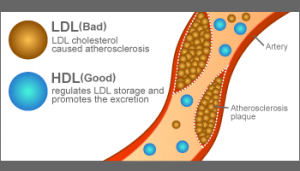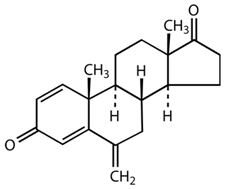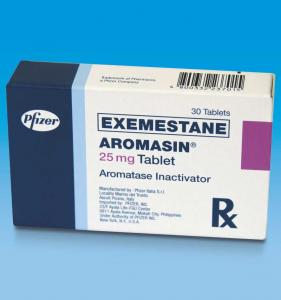Overview and History of Aromasin
Aromasin belongs to a category and class of drugs known as aromatase inhibitors (AIs). Aromatase inhibitors belong to an even broader class of drugs known as anti-estrogens. The other subcategory of drug under the anti-estrogens classification is the selective estrogen receptor modulators (SERMs), such as Nolvadex and Clomid. AIs and SERMs make up anti-estrogens. Aromatase inhibitors differ greatly from SERMs in their action and how they deal with the issues of estrogen control.
There exists a gross misunderstanding that has perpetuated the anabolic steroid using and bodybuilding community for years, but the clarification has become much better lately within the last 10 – 15 years. It is the myth and misunderstanding that that SERMs, such as Nolvadex and Clomid, act to lower estrogen levels. This myth most likely stems from the fact that SERMs too are referred to as ‘Estrogen blockers’, and so various individuals may have misunderstood ‘blocking Estrongen’ to mean ‘Estrogen elimination’, which could not be further from the truth. SERMs instead only block the activity of Estrogen in select tissues in the body by way of blocking the action of Estrogen at the receptor sites in breast tissue by occupying the receptor sites in place of Estrogen so that Estrogen itself cannot exert its effects there through receptor site binding. SERMs will also act as Estrogens at receptor sites at other cells in other areas of the body (the liver, for example in Nolvadex’s case). This is where the “selective” part of ‘selective Estrogen receptor modulator’ comes into play. However, SERMs do no reduce circulating levels of Estrogen in blood plasma. Aromatase inhibitors are the compounds that instead serve to do this by eliminating the production of Estrogen through binding to and disabling the aromatase enzyme, which is the enzyme responsible for the conversion (or aromatization) of androgens into Estrogen.
Aromasin is a very strong and very potent steroidal aromatase inhibitor of the suicidal type, and information within the packaging in prescription Aromasin describes the ability for Aromasin to reduce Estrogen levels by 85%, as evidenced by studies on breast cancer patients[1]. Suicidal aromatase inhibitors such as Aromasin (Exemestane) serve to permanently inhibit and disable the aromatase enzyme to which it is bound to[2]. This renders the enzyme inactive forever. The body will eventually manufacture more aromatase enzymes, but the currently bound enzymes are bound indefinitely, eliminating any risk for Estrogen rebound. This is unseen with the other two major aromatase inhibitors (Arimidex and Letrozole), which are non-suicidal aromatase inhibitors that are only bound to the aromatase enzyme for limited time periods before the aromatase inhibitors unbind and become metabolized. If a non-suicidal aromatase inhibitor is halted too abruptly, the circulating inhibited aromatase enzymes that have not been metabolized out of the body will then become free again, and begin aromatizing androgens into Estrogens at an often rapid rate. This is not the case with Aromasin.
Exemestane was initially designed by Pharmacia & Upjohn for the treatment of female breast cancer patients, specifically post-menopausal patients, and it is used as an adjunct therapy when other first-line treatments for breast cancer (such as Nolvadex) have failed. Shortly after development, the FDA approved the use of Aromasin (Exemestane) for sale on the prescription drug market in 1999, but was then sold under the Aromasin brand name in 2000. Since its initial release, its use and sales has spread across the world internationally and is utilized in almost every country in the world. The brand name of Aromasin, due to various patents and marketing/production laws, is currently the only officially manufactured and sold Aromasin product and is very widely available across the world. The standardized dose of Aromasin (Exemestane) is that of 25mg (and is sold as 25mg tablets), but research has demonstrated that it is effective at doses as low as 2.5mg daily.
It makes natural sense to realize that the properties and effects of Aromasin would then become a benefit for the anabolic steroid using athlete for the purpose of Estrogen control. The use among anabolic steroid using athletes is for the control of almost all Estrogen-related side effects: the manifestation of gynecomastia, water retention and bloating, rising blood pressure (as a result of water retention increases from Estrogen). This is in contrast with SERMs such as Nolvadex, which only serve to block gynecomastia. As with many aromatase inhibitors, Aromasin has also demonstrated to increase levels of endogenous Testosterone production in men, which will be discussed further in this profile.
Although Aromasin is regarded by many anabolic steroid users and bodybuilders as being far more effective and far more useful (due to the suicidal inhibition) than Arimidex, Arimidex still today remains far more popular among the anabolic steroid using community. This is simply because Arimidex was developed and released before Aromasin, and therefore anabolic steroid using bodybuilders and athletes took notice of it sooner. Aromasin (Exemestane) to a degree was, in a way, overlooked and missed by many. Today this is beginning to change, where many individuals are now noticing the superiority and advantages of Aromasin over Arimidex (of which there are many, which will be described in detail throughout this profile). Some of these advantages that are not seen in any other aromatase inhibitors include: suicide inhibition, stimulating increases in IGF-1 (Insulin Like Growth Factor 1), displays little incompatibility with other compounds (something not seen with other aromatase inhibitors), as well as offering less of a negative impact on cholesterol values (again, something unseen with other aromatase inhibitors).
Aromasin Properties and Actions:
Aromasin is a steroidal suicidal aromatase inhibitor. This means that it possesses the characteristic four ring cycloalkane carbon structure common of all steroidal molecules. The fact that Exemestane is a steroidal aromatase inhibitor is the prime reason as to why it is a suicidal aromatase inhibitor that remains permanently bound to the aromatase enzyme. As the aromatase enzyme is highly attracted to the steroidal structure of the androgens (Testosterone) it aromatizes into Estrogen, Aromasin’s chemical structure essentially ‘fools’ the aromatase enzyme into binding with it, only to become inhibited/deactivated. Because the binding strength is so great, this inhibition becomes permanent for the aromatase enzyme that Aromasin has become bound to. A similar steroidal aromatase inhibitor, Formestane, exhibits the exact same characteristics (although it is much weaker and less potent in comparison to Aromasin). This is why there is absolutely no risk of Estrogen rebound when Aromasin administration is abruptly halted.
The other two major aromatase inhibitors (Arimidex and Letrozole) are non-steroidal and therefore non-suicidal aromatase inhibitors that are associated with the risks of Estrogen rebound following discontinuation. This is because unlike Aromasin, they are not structurally similar to the aromatase enzyme’s target hormones.
Aromasin is extremely effective at 25mg daily for the reduction of serum circulating Estrogen levels in the body, as demonstrated earlier with its ability to reduce Estrogen by 85%. As with other second-line breast cancer treatments, Aromasin is so effective at inhibiting the aromatase enzyme (and thereby reducing Estrogen levels) that this compound is, like Arimidex, only administered to post-menopausal females, and/or utilized when other first-line treatments for breast cancer has failed. This is because post-menopausal females possess a very different shift in hormone levels and endocrine function in comparison to pre-menopausal females.
Arimidex and Letrozole are both classified as non-steroidal and non-suicidal aromatase inhibitors that compete with the substrate for binding to the enzyme active site. This is very different from Aromasin (Exemestane), which is a steroidal and suicidal aromatase inhibitor that acts as a mechanism-based steroidal inhibitor that mimics the substrate, is converted by the enzyme to a reactive intermediate, and results in the inactivation of the aromatase enzyme[3]. For ease of understanding, what this means to the layman is that Aromasin’s chemical structure resembles the traditional ‘targets’ that aromatase binds to (Testosterone, for example) and that it essentially ‘fools’ the aromatase enzyme into binding with it, only to become inhibited/deactivated. Because the binding strength is so great, this inhibition becomes permanent for the aromatase enzyme that Aromasin has become bound to. Arimidex and Letro, being non-suicidal aromatase inhibitors, both compete with the enzyme’s traditional ‘targets’ rather than being assured a permanent spot (which is the advantage that Aromasin has over the other two).
Athletes, bodybuilders, and individuals engaging in the use of anabolic steroidswill favor the use of aromatase inhibitors such as Aromasin for their usefulness in reducing, mitigating, and avoiding Estrogenic side effects. These side effects are result of the aromatazation (or conversion) of aromatizable androgens (such as Testosterone) into Estrogen, which often results in far greater than normal physiological levels of Estrogen in the body. This is where the use of Aromasin (Exemestane) is very beneficial and highly favored among anabolic steroid using individuals, as Aromasin eliminates the issue of rising Estrogen levels at the root cause: By binding to and inhibiting/disabling the aromatase enzyme, supraphysiological levels of aromatizable androgens (such as Testosterone, Dianabol, Boldenone, etc.) cannot convert into Estrogen, thereby eliminating any possible risk of Estrogen-related side effects.
Aromasin Side Effects:
Aromasin is known for being fairly tolerable throughout the majority of users. However, it is not without its potential side effects, and there are some of concern. They are usually as a result of a reduction in Estrogen levels that is too much, or too fast, or Estrogen suppression for too long. It’s also important to understand that the use of Aromasin (or any aromatase inhibitors) results in a greater side effect profile for women than for men.
The first Aromasin side effect that individuals tend to encounter is that of joint and/or bone pain. This is because Estrogen plays a significant and important role in maintaining proper mineralization and bone density within bone tissue. Although this is a characteristic of all aromatase inhibitors, Aromasin has been shown in studies to actually strengthen bone tissue (to a point), while AIs like Arimidex (Anastrozole) and Letrozole (Femara) have shown severe reductions in the same.
Lethargy and fatigue is a frequently reported side effect of Aromasin, and all other AIs. Estrogen plays a key role in the Central Nervous System (CNS), and dropping Estrogen levels too low for any reason with any compound can often result in daily chronic fatigue. A return of Estrogen levels to normal physiological levels should mitigate this side effect.

HDL and LDL impairment
Negative cholesterol changes are another significant risk with any AI use, and Aromasin is no exception. Being that Estrogen plays a critical role in the maintenance and management of proper cholesterol health, the severe reduction of it can result in negative impacts to LDL and HDL values. However, Aromasin has proven in studies to have a lesser negative impact here than other aromatase inhibitors. However, the risks still do exist and regular checkups and bloodwork should be done.
The only Aromasin side effects that could be said to be unique to Aromasin is the possibility of androgenic side effects. This is possibly due to Aromasin’s structural properties as an androgenic steroid in and of itself. Androgenic side effects can and do include things like increased oily skin (and acne as a result), increased facial and body hair growth, and the trigger of MPB (Male Pattern Baldness) provided the genetics are there for it. It is also possible that a noticeable boost in aggression and drive can result from Aromasin use, though perhaps not as significant as more potent androgens, such as Masteron (Drostanolone).
Dosing and Administration of Aromasin:
Medically, Aromasin is utilized to treat post-menopausal breast cancer patients as a second-line procedure when first-line treatments have been unsuccessful. In this case, for cancer treatment, an Aromasin dosage of 25mg per day is warranted. It is also suggested within prescription instructions that it should be taken after a meal.
Aromasin For Gynecomastia and Estrogen Control On-Cycle:
In order to treat gynecomastia and ongoing control of Estrogen during a cycle of anabolic steroids, an average dosage tends to be 12.5 – 25mg per day. Some users have even opted for a 12.5 every other day protocol, but this is highly dependent on what aromatizable anabolic steroids are being used, and how much (dosage wise) is used as well. Other individuals will keep Aromasin available on-hand, but elect to not use it unless or until an Estrogen-related side effect or issue comes up. In that event, the individual might opt to take a full 25mg dosage until side effects subside, and then drop the dosage down to 12.5mg per day, and eventually perhaps 12.5mg every other day, or even less frequently.
Aromasin For Post Cycle Therapy (PCT):
It has been shown in studies that Aromasin can and does indeed increase endogenous natural Testosterone levels in men by 60%, which is considerably significantm especially after only a 10-day period. 25mg per day for no greater than 2 weeks is the ideal Aromasin dosage for this purpose. Nolvadex is normally utilized for 4 weeks at a dosage of 20-40mg alongside Aromasin concurrently.
Aromasin possesses a half-life of approximately 27 hours. It can be administered at any time of day, but studies and prescription instructions suggest that there may be better absorption by the body if Aromasin is consumed with food. It’s also imperative to understand that Aromasin requires a full 7 days to allow the body to achieve peak blood plasma levels of the compound.
It is also very important to understand that with any compound like Aromasin where Estrogen levels are being reduced, the concept and idea here should be control of Estrogen levels, and not elimination of them. Elimination of Estrogen levels can result in very dire consequences, especially in the long run. Estrogen should merely be controlled to proper levels (if needs be), and then the aromatase inhibitor (in this case, Aromasin, for example) should be halted, discontinued, or have the dosage dropped significantly. Severe reductions of Estrogen levels not only result in an increase of negative side effects, but it will also affect muscle gains in a negative manner over the long term.
Aromasin Legality & Availability:
Much like many other ancillary compounds and anti-estrogens, Aromasin is mostly an uncontrolled substance in most of the world. While it remains a prescription-only item in the United States and Canada, for example, it is not illegal to purchase, own, or possess Aromasin even though it is not an over the counter product in these countries. There are a good number of countries in the world in Asia, the Middle East, and Eastern Europe where Aromasin is free and readily available as an over the counter drug. It is a very widely available compound, only limited by its popularity, as for the time being it seems to be less popular than other aromatase inhibitors like Aromasin and Letrozole, most likely because Aromasin was a late addition to the bodybuilding and anabolic steroid use scene.
How to Buy Aromasin Online:
Aromasin tends to be third in popularity out of the 3 primary aromatase inhibitors (Arimidex, Letrozole, and Aromasin), but it is still quite popular as an ancillary anti-estrogen that people look for in order to run their cycles a little safer and with less hassle. Most anabolic steroid sources, websites, dealers, etc. tend to offer Aromasin in their inventory, and there are a wide variety of brands available, ranging from underground labs, to pharmaceutical grade Aromasin, albeit more expensive. There also exists research chemical grade product, which is Aromasin (usually in liquid form), that is marketed by research companies as research chemicals for research purposes only. Quality, cost, and consistency can vary between all labs and brands mentioned.
Obviously, depending on the source, Aromasin on the anabolic steroid black market can vary in price. However, for underground (UGL) grade Aromasin, most buyers can expect to encounter prices in the range of $1.45 – $5.00 per 25mg tablet. Pharmaceutical grade Aromasin can be found in the range of $5 – $10 per 25mg tablet. Lastly, there are the research chemical products, which tend to offer Aromasin in a 30ml bottle at a concentration of 25mg/ml for anywhere from $30 – $70 per bottle, depending on which research chemical company is being
Chemical Information:
 Exemestane (AKA Aromasin)
Exemestane (AKA Aromasin)
Chemical Name: 6-Methylideneandrosta-1,4-diene-3,17-dione
Molecular Weight: 296.403 g/mol
Formula: C20H24O2
Original Manufacturer: Pharmacia & Upjohn
Half Life: 27 hours
Detection Time: 2 weeks
Anabolic Rating: N/A
Androgenic Rating: N/A





